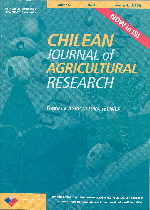
|
Agricultura Técnica
Instituto de Investigaciones Agropecuarias, INIA
ISSN: 0365-2807
EISSN: 0365-2807
Vol. 66, No. 3, 2006, pp. 264-270
|
 Bioline Code: at06028
Bioline Code: at06028
Full paper language: Spanish
Document type: Research Article
Document available free of charge
|
|
|
Agricultura Técnica, Vol. 66, No. 3, 2006, pp. 264-270
| en |
Urea milk contents in dairy cows of Bío-Bío Region, Chile
Pedraza, Carlos G.; Mansilla, Alberto M.; Merucci, Fabio D.; Pinedo, Pablo & Contreras, Horacio C.
Abstract
This study was performed using a database of the Dairy Control Service of Bioleche Ltd., Los Angeles, Chile. The information was analyzed by a mathematical model that evaluated urea content as a dependent variable of the following factors: ordinal number of calvings, calving season, daily level of milk production, somatic cell count (RCS)and interactions between the mentioned factors. Urea content (mg 100 mL-1) for cows of first and second or more calvings was 29.07aand 33.35b (p < 0.05), respectively. The calving season was significantly associated with mean urea values reaching 33.24a; 30.76b; 29.86b; and 30.97b (p < 0.05) in spring, summer, autumn and winter, respectively. Levels of protein less than 3.2 % and more than 3.2 % had mean values of 32.87a and 29.54b (p < 0.05), respectively. Averages were 33.47a, 31.43b, and 26.73c (p < 0.05) for daily levels of milk production between 0-15 L,between 15-25 L, and more than 25 L, respectively, and average values of 29.32a, 31.87b, and 32.43b (p < 0.05) corresponding to somatic cell count levels of less than 100,000, between 100,000 and 400,000, and more than 400,000, respectively. Significant interactions(p < 0.05) were found between the level of milk production and ordinal number of calving, and between the calving season and the level of milk production.
Keywords
milk, urea, protein, somatic cell count, dairy cow.
|
| |
| es |
Niveles de urea láctea en vacas de la Región del Bío-Bío, Chile
Pedraza, Carlos G.; Mansilla, Alberto M.; Merucci, Fabio D.; Pinedo, Pablo & Contreras, Horacio C.
Resumen
El presente estudio se realizó utilizando una base de datos del Servicio de Control Lechero de la empresa Bioleche Ltda., Los Ángeles, Chile. La información fue analizada mediante un modelo matemático que consideró como variable dependiente el nivel de urea en función de los factores: número ordinal de parto, época de parición, nivel de proteína de la leche, nivel de producción diaria de leche, recuento de células somáticas (RCS) y las interacciones entre los factores mencionados. El contenido de urea (mg 100 mL-1) en vacas de primer y de segundo o más partos fue 29,07a y 33,35b (p < 0,05), respectivamente. La estación del año en que ocurrió el parto se asoció significativamente (p < 0,05) con los valores promedios de urea láctea, alcanzando a 33,24a; 30,76b; 29,86b; y 30,97b en las estaciones departos de primavera, verano, otoño e invierno, respectivamente. Valores medios de 32,87a, y 29,54b (p < 0,05) entre los niveles de proteína inferior a 3,2 % y superior a 3,2 %, respectivamente. Promedios de 33,47a, 31,43b y 26,73c (p < 0,05) en los niveles de producción diaria de leche entre 0-15 L, entre 15-25 L y más de 25 L, respectivamente, y valores medios de 29,32a, 31,87b, y 32,43b (p < 0,05) correspondientes a los niveles de recuento de células somáticas menores a 100.000, entre 100.000-400.000, y mayores a 400.000, respectivamente. Se encontraron interacciones significativas (p < 0,05) entre nivel productivo de leche y número ordinal del parto, y entre estación del parto y nivel productivo de leche.
Palabras-clave
leche, proteína, urea, recuento de células somáticas, vacas lecheras.
|
| |
© Copyright 2006 - Instituto de Investigaciones Agropecuarias, INIA (Chile).
Alternative site location: http://www.inia.cl/at/agritec.htm
|
|
